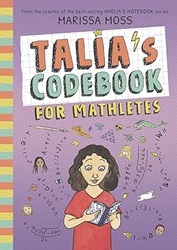
 Talia's Codebook for Mathletes
Talia's Codebook for MathletesReview posted March 1, 2024.
Walker Books, 2023. 232 pages.
Review written January 15, 2024, from a library book
Starred Review
2024 Mathical Book Prize Winner, Grades 6 to 8
Oh, this book made my math-loving heart happy! Though I do believe you don't have to love math to enjoy this book. It's a middle school story, illustrated in the manner of the Wimpy Kid books, but in color. It's one of those books I have to look at in my job and decide if we should shelve it with the graphic novels or with the regular text books, and this leans into illustrated novel rather than graphic novel, because the majority of the story is told with paragraphs rather than panels. But I do believe there are pictures on every single spread, so it's all the more inviting for kids. (A little less inviting for me, not being a graphic novel fan, but that's another story. Once I picked this up, I loved it.)
Talia is starting middle school and is sad that her best friend, a boy named Dash, doesn't want to be seen with her at school, because some boys have been teasing him. This gets Talia thinking about the rules of middle school and how you're supposed to figure out what you should wear, what you should say, and what's cool. Can she figure out the code?
But Talia's happy that Dash will be on the Mathlete team with her. Trouble is, it turns out that she's the only girl. When the boys on the team don't seem to take her seriously, ignore her idea of using codes to build their math skills, and say that she's the one who should be friendlier, Talia decides to start a Mathlete team for girls only. Both teams are at their first competition, and can the Math Mermaids decisively show that girls can do math, too?
That's a big thread in the book, but there's a lot more going on about friendship, family, fitting in, and codes -- with plenty of interesting example codes and some problems to puzzle out and codes to break.
Now I, of course, resonated with only one girl on the math team. My approach to that situation was to try to beat them all, but I like the way in this book there was a more nuanced message, but we did firmly get the message that math is for everyone, and math is fun. And I liked the wider application of the principle of coded messages, for example the code behind people's facial expressions or how to be cool.
